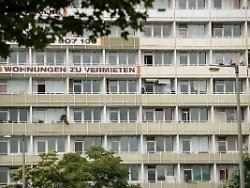Tuesday, December 14, 2021
Trend reversal in the housing market
The vacancy rate is rising for the first time in years
The lack of housing and rising rents have been among the biggest problems in major German cities for years. But now there are signs of a trend reversal. For the first time in 14 years, the number of vacant apartments is also increasing in so-called swarm cities.
For the first time in 14 years, the number of vacant rental apartments in Germany has risen slightly, and not only in structurally weak migration regions, but also in some large cities with a tight housing market. According to data from the analysis company Empirica, the vacancy rate in the market at the end of 2020 – these are the most recent figures – grew slightly to around 611,000 units. That is around 8,000 apartments more than a year earlier. The vacancy rate remains unchanged at 2.8 percent.
Market active means that the apartments must be immediately rentable or capitalizable in the medium term. Since 2006, the number of vacant apartments throughout Germany has fallen continuously. Only in a few rural regions suffering from emigration did vacancies rise. While the camps on the housing markets in the so-called swarm cities, which experienced high internal immigration, became more tense.
This tide has now turned in the Corona year. For the first time since 2006, the vacancy rate is even increasing in the swarm cities: from 98,000 in the previous year to 102,000 apartments in 2020. The lowest vacancy rates are currently in the cities of Munich and Frankfurt am Main with 0.2 percent and Münster with 0 , 3 percent. At the other end of the scale are Pirmasens and Frankfurt an der Oder with 9.3 and 9.1 percent vacancy respectively.
Something is happening with supply and demand
Even if the rise in vacancy in the swarm cities is initially only minimal, and it remains to be seen whether the corona pandemic has temporarily distorted the statistics, the Empirica experts see another sign of an incipient turnaround in the housing market. “The rents in the swarm cities have been growing more slowly for three years than in the surrounding areas,” the researchers write. “Now the development of vacancies also points to a trend break.”
The “times of the great urban influx” should be over for the time being, it goes on to say. This is shown not least by the immigration to the suburbs, which has been going on for years. But it is not only the demand side that is relieving the housing markets in large cities. Something has also happened on the supply side: In the meantime, twice as many new apartments are being built in the swarm cities than ten years ago. Relief is therefore inevitable, at least in the medium term.
